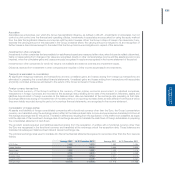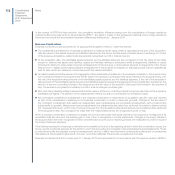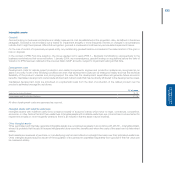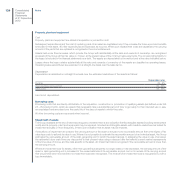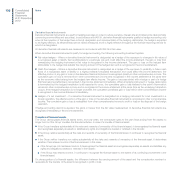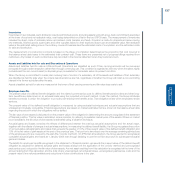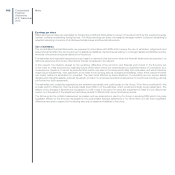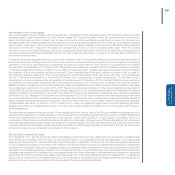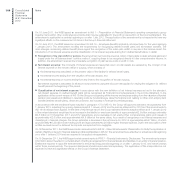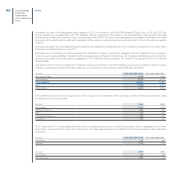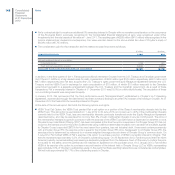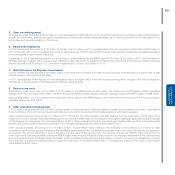Chrysler 2012 Annual Report Download - page 142
Download and view the complete annual report
Please find page 142 of the 2012 Chrysler annual report below. You can navigate through the pages in the report by either clicking on the pages listed below, or by using the keyword search tool below to find specific information within the annual report.
141
Consolidated
Financial Statements
at 31 December 2012
Recoverability of non-current assets
Non-current assets include Property, plant and equipment, Goodwill and Other intangible assets with indefinite useful lives, Other
intangible assets, equity investments and Other financial assets. The Group periodically reviews the carrying amount of non-current
assets held and used and that of assets held for sale when events and circumstances warrant such a review. For Goodwill and
Intangible assets with indefinite useful lives such analysis is carried out at least annually and when events and circumstances warrant
such a review. The analysis of the recoverable amount of non-current assets is usually performed using estimates of future expected
cash flows from the use or disposal of the asset and a suitable discount rate in order to calculate present value. When the carrying
amount of a non-current asset is impaired, the Group recognises an impairment loss for the amount by which the carrying amount of
the asset exceeds its estimated recoverable amount from use or disposal determined by reference to the cash flows included in its
most recent business plans.
In respect of the future expected cash flows used in this analysis, in view of the persisting difficult economic and financial situation in
Europe as well as the remaining uncertainty for the other environments where the Group operates, the various regions and operating
segments of the Group have taken into consideration the expected performance for 2013 and 2014 consistent with the updated
financial plan communicated on 30 October 2012. Assumptions and results are consistent with the statements made in the section
– Subsequent events and outlook. In addition, for the plans of subsequent years, prudent assumptions have been made considering
the persistent difficult and uncertain trading environment. Future expected cash flows also consider the effects of the process for
the continuing strategic realignment of the manufacturing and commercial activities of Fiat with those of Chrysler, which accelerated
from 2011 following the acquisition of the control of Chrysler, and is progressing in line with expectations. On the basis of these
considerations, the Group assessed the recoverability of the book value at 31 December 2012 for the Net Capital Employed pertaining
to the EMEA car mass market operations. Given the strategy announced on 30 October 2012, to redeploy the industrial assets in
EMEA to produce a renewed product portfolio focused on upper-end segments and international brands, it was considered reasonable
to use cash flow projections for the period 2013-2018. These were discounted at a base 13.14% pre-tax Weighted Average Cost of
Capital (WACC) and the long term growth rate was prudently assumed to be 0%. Sensitivities were performed simulating two different
scenarios: a) WACC was increased by 1% for 2017 and 2% for 2018 and for Terminal Value; b) cash-flows were reduced by estimating
the impact of a 10% decrease in the European car market demand for 2016-2018 as compared to the base assumptions. In all cases
the recoverable amount of the net assets continue to be higher than their book value. Furthermore an analysis on specific classes of
assets was also performed leading to the recognition of a €108 million write down in 2012 mainly related to Development costs and
Tangible assets (see Notes 15 and 16). In 2011, a total of €713 million of impairment losses were recognised regarding Goodwill,
Development costs and Tangible assets mainly in the car mass market operations in EMEA and the Components and Production
Systems segments.
The estimates and assumptions used as part of this analysis reflect the current state of the Group’s available knowledge as to the
expected future development of the businesses of the various regions and operating segments and are based on a realistic assessment
of the future development of the markets and the car industry, which remain subject to a high degree of uncertainty due to the
continuation of the economic and financial crisis and its effects on the industry. Although current Group estimates do not indicate any
other business areas with possible impairment losses on non-current assets, any future developments in the economic environment
or Group performance that result in actual performance that differs from the original estimates, could result in the need for the carrying
amounts of certain non-current assets to be adjusted in future periods.
Recoverability of deferred tax assets
At 31 December 2012, the Fiat Group had deferred tax assets on deductible temporary differences and theoretical tax benefits arising
from tax loss carry-forwards of €9,749 million, of which €4,918 million is not recognised in the financial statements. The corresponding
balances at 31 December 2011 were €9,202 million and €4,363 million, respectively. The Group has recorded these valuation allowances
to reduce deferred tax assets to the amount that it believes it is probable will be recovered. In making these adjustments, management
has taken into consideration figures from budgets and plans for subsequent years consistent with those used for impairment testing and
discussed in the preceding paragraph relating to the recoverable amount of non-current assets. Moreover, the adjustments that have been
recognised are considered to be sufficient to protect against the risk of a further deterioration of the assumptions in these plans, taking into
account the fact that the net deferred tax assets recognised relate both to temporary differences and to tax losses which, to a significant
extent, may be recovered over an indefinite time period and are therefore recoverable even in a scenario where the time needed for an
economic recovery to occur extends beyond the term implicit in the above-mentioned estimates.


